-
Ford Explorer Community - Maintenance - Modifications - Performance Upgrades - Problem Solving - Off-Road - Street
Explorer Forum Covers the Explorer ST, Explorer Sport, Explorer Sport Trac, Lincoln Aviator,
Mercury Mountaineer, Mazda Navajo, Ford Ranger, Mazda Pickups, and the Ford Aerostar
Register Today It's free!
You are using an out of date browser. It may not display this or other websites correctly.
You should upgrade or use an alternative browser.
You should upgrade or use an alternative browser.
Turbo 4 Conversion, The Nasty Hoe Gets Blown!
- Thread starter SVO
- Start date
Elite Explorer members see no advertisements, no banner ads, no double underlined links,.
Add an avatar, upload photo attachments, and more!.
- Joined
- May 3, 2003
- Messages
- 9,361
- Reaction score
- 63
- City, State
- Smithville/Austin, Tx
- Year, Model & Trim Level
- 08' Suzuki SX4
However, if your rock crawler becomes faster than my GT, I will be very angry.
Ummmmmm And I just picked up that new turbo today too

Almost didn't make it back to class on time (4 min to spare), thank thy Wicked Evil one you have a fairly fast car you let me borrow today

I may have overlooked it, but what did you do with the 5speed and related parts to it?
Ah you must ask Kris G. about that one
Ask him about the two drive train swaps and one 2x4 to 4x4 conversion in one day
I spy something from my old rig
Good eye, keeping it all in check sir, (Support Brace)

Jeff - Just another day in the life of Explorering
- Joined
- February 12, 1999
- Messages
- 4,153
- Reaction score
- 87
- City, State
- Austin,Tx
- Year, Model & Trim Level
- 92 Nav, 99 Mounty, 98 Ex
Here is the 5-speed and related parts. including the Nasty *cough* I mean Turbo Ho's old motor....


- Joined
- May 3, 2003
- Messages
- 9,361
- Reaction score
- 63
- City, State
- Smithville/Austin, Tx
- Year, Model & Trim Level
- 08' Suzuki SX4
Slotted the cross member and moved the motor mounts back, now I have a 10* list to the driver's side I'll need to compensate for by slotting the cross member up and down.
I was only able to spend an hour on it this weekend, so this is as far as I have gotten, hopefully I'll get to spend more time with it over the hollidays.
Remember this is mearly test fitting/mocking up, to see what needs to be done to get to the final fitment stage.




I was only able to spend an hour on it this weekend, so this is as far as I have gotten, hopefully I'll get to spend more time with it over the hollidays.
Remember this is mearly test fitting/mocking up, to see what needs to be done to get to the final fitment stage.
Attachments
- Joined
- May 3, 2003
- Messages
- 9,361
- Reaction score
- 63
- City, State
- Smithville/Austin, Tx
- Year, Model & Trim Level
- 08' Suzuki SX4
its so small.. just out of curiosity, what are the hp/tq numbers from that?
To add about the 4 cylinder swap, the 2.3 has a nearly infinately adjustable power band, you can get an adjustable cam sproket and (unlike the old slotted ones in 2* incriments) in less than 60 seconds adjust the cam timing, advance or retard to put the power band where you want it, like off idle to midrange in this case, to make power down low, coupled with using a N/A TFI ignition modual which has a more agressive timing curve than the Turbo TFI modual which has a more gradual timing curve.

Not to mention then you can play with base timing on the distributor too.
A little more indepth is swapping the 2.3 crank for the 2.5 Ranger crank, simple bolt-in/swap, no serious mod work to make this happen.
Even more radical would be the custom 2.9 crank from Esslinger, discontinued but still able to be found kit
But it's not hard to mod nor get 200+ hp out of these motors.
Lets look at a few numbers:
1992 Navajo 4.0 V-6
160hp and 225tq
1988 T-Bird Turbo Coupe
190hp and 210tq
See there pretty close, dialing this motor in and doing some mods will put me right back to where I was to begin with and a bit more, and shaving wieght of the nose of the truck, but having the ability to adjust my power band is even more benifical.
Yes a stall maybe needed, but well see about that after the shake down runs, the main thing is to make it where it doesn't have what we call "Peaky" horse power, you want it to come on smooth and predictable, not a sudden rush and non-managable (Peaky).
Cam changes ane easy and take no less than about an hour, there is everything from two primary roller cams to more than a handfull of flat tappet cam available, all the way to custom ground.
Clipped and trimmed turbos for as far as the eye can see, and bleed valves to tune to the boost levels you want.
The heads will accept over sized valves, in the 1.90/1.65 range and porting and polishing are also welcome, headers are available, from cheap log styles like this:
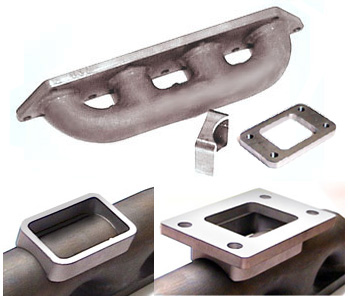
To radically over priced equal length's, which I have never seen any of the numbers they claim are to be gained:
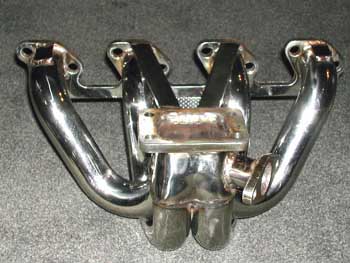
I honestly belive a 200-250hp motor will work great in this set-up with a set of 5.13's, and one day when I'm rich and not so famous an Atlas with the 4.3:1 ratio would be the cherry on the pie.
The nice thing is that if you break the timing belt the motor just shuts off, install another $9 belt and away you go again, no piston to valve clearance issues, nothing broken, and a 30min repair trail side with a minimal amount of effort and tools.
Fuel consumption should also be less of a factor, cause as long as your not in the boost, it's mearly a 4 pot motor.
Upgraded fuel pump and FPR are manditory for tuning and can net you an easy 5-8hp from fuel tuning along with inital timing.
Turbo motors take to free mods like a fat kid on a cupcake too, open elemet filters, removal of all accordian intake hoses/restrictions/air cleaner assy, and exhaust restrictions, underdrive pulleys, sythetics, and ALT draws.
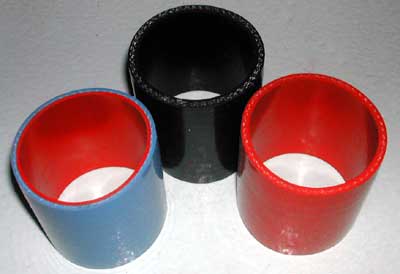
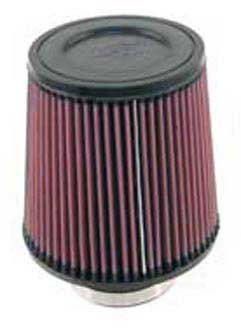
Then of course we can get into personal programming, but that is way down the line from this point:
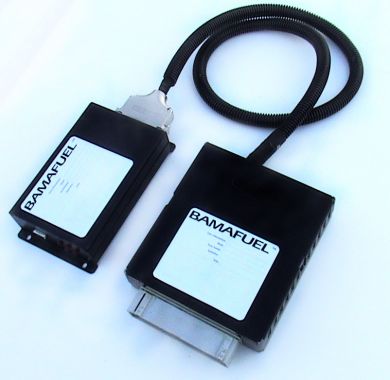
http://www.youtube.com/watch?v=xZvhCSYIIjA
http://www.youtube.com/watch?v=3BNqDdlzjxI
http://www.youtube.com/watch?v=cBNCT4AvzMc
General 2.3T mod list, presented in an approximate order that most people would generally do them in.
The boost can be turned up at any time, but results will vary based on modification level. Top quality fuel should be used at all times, and detonation religiously monitored for. Taking care not to hurt your motor can be made much easier by the purchase of an air/fuel ratio monitor (about $70). This is highly recommended when you get to the point of changing the cam, or turning up the boost.
Stage 0:
Get the car running right!
Put decent tires on it!
Take it to the strip and get some baselinenumbers for it.
At sea level, an 85.5+ should run a low 15/high 14, and an early model should run a low-mid 15. These times assume decent traction and driving.
Stage 1:
Disconnect the knock sensor FREE
K&N Air filter/no air box $30-$50
Adjustable boost $5-$500
At first glance, this would seem nuts, based on the paragraph above. BUT, the knock sensor is easily fooled by non-detonation noises into pulling out timing when it shouldn't, and it takes out way too much. People generally run faster when they disconnect it...you gotta use your brain to avoid detonation and broken parts.
Turn up boost till the overboost buzzer just comes on, this is about 17.5 psi OR set it wherever you want (see fuel meter again) ;-).
The best number I've heard of so far for an SVO at this stage was an 86 that ran a 13.75 on slicks. This was posted by a list member a while back.
Stage 2:
Big exhaust $200-$1000
Engle cam $150
Tbird Intercooler (optional, save your money for a serious one if you're going to go farther than stage 2) $50
Late model computer and injectors for early model owners $200?
When this becomes a requirement will depend on a lot of things, but generally, if you're running 95mph or more in the quarter mile in a stock weight SVO (~230hp), it's time. For some people this may happen before the cam change. You need to be sure that the computer you buy was from an intercooled car (late SVO, or late Tbird TurboCoupe). The computer mapping was different for inter-cooled versus non-intercooled applications. Late model SVOers may also want to consider going to a higher flow fuel pump at about this point. The early model double-pump system should be OK for most applications. If you're going to use nitrous at some point, go all out on the fuel pump(s).
At this point, you should have gained at least 5 or 6 mph, and half a second off your baseline time. Typical gains would be closer to a full second, if for no other reason than that you should be getting to be a pretty good driver by now ;-).
Stage 3:
Good intercooler $250-$1250
High flow turbo $600-$800
Ported Manifolds FREE-$1000
Stage 4:
All out Ported head/big valves/maybe bigger cam FREE-$2000
Stage 5:
Parts exist to do an all-aluminum 3 liter 8000RPM stroker motor if you want to go nuts. This will require more fuel than the stock 86 system can provide. Currently you're on your own for such things... BIG BUCKS!
Other things like underdrive pulleys ($50) and cam timing pulleys ($50-$100) can be played with as desired. Prices vary depending on the deals you find, and how much of the work you can/will do yourself. There's always nitrous for those who are inclined to deal with it, and to take the necessary precautions.
Results will vary, but 13s in the mid 90s can be run on the 30# injectors, and 12s at a few mph over 100 can be run on the 36s, both without nitrous. With nitrous and some creativity, a lot more is possible.
Cause it's not the size of your pee pee, it's how you use it :wink
But, you already knew that

- Joined
- May 3, 2003
- Messages
- 9,361
- Reaction score
- 63
- City, State
- Smithville/Austin, Tx
- Year, Model & Trim Level
- 08' Suzuki SX4
John_Rock
Elite In Memoriam
- Joined
- January 5, 2001
- Messages
- 4,339
- Reaction score
- 37
- City, State
- Houston, TX
- Year, Model & Trim Level
- 2001 Sexy Sport Trac 4x4
Ok, it won't whine as loud or long as a supercharger, but your truck will still be a whiny ***** on the trail. If you see some burnout tracks in your front lawn Wed. or Thu. I'm sure it won't be from me.It's not a supercharger John
- Joined
- August 3, 2000
- Messages
- 35,099
- Reaction score
- 12,039
- City, State
- NORTH IDAHO, 7B
- Year, Model & Trim Level
- B2 "Slightly" Modified
- Callsign
- FOURTEN
AWESOMENESS
I bought my old 4.0L headers from a guy running a 2wd Ranger 2.3L SVO setup at 22 psi, copper head gaskets, water injected on the intercooler, etc claimed under 12 seconds at bandimere (mile high)
He was an SVO nut case, had 3ea 2.3L t stangs sitting around.....
Ever since then (10 years now) I have really wanted to see a 2.3L t BII or Explorer.....
so thanks! Should be awesome if tuned and built right, which we all know you will do!
I bought my old 4.0L headers from a guy running a 2wd Ranger 2.3L SVO setup at 22 psi, copper head gaskets, water injected on the intercooler, etc claimed under 12 seconds at bandimere (mile high)
He was an SVO nut case, had 3ea 2.3L t stangs sitting around.....
Ever since then (10 years now) I have really wanted to see a 2.3L t BII or Explorer.....
so thanks! Should be awesome if tuned and built right, which we all know you will do!
- Joined
- May 3, 2003
- Messages
- 9,361
- Reaction score
- 63
- City, State
- Smithville/Austin, Tx
- Year, Model & Trim Level
- 08' Suzuki SX4
Ok, it won't whine as loud or long as a supercharger, but your truck will still be a whiny ***** on the trail. If you see some burnout tracks in your front lawn Wed. or Thu. I'm sure it won't be from me.:
There is NO Whine to a turbo John, think more of a jet engine turbine sound sir, and a pissed off bee on the back side:
http://projecthp.ford23.com/Videos/2.3TMustangSVOJDB9.6Run.avi
http://projecthp.ford23.com/Videos/2.3TSVOMustangJDBFourced.mpeg
Thanx, you could stop by, you know, but fine, Fack You!
AWESOMENESS
I bought my old 4.0L headers from a guy running a 2wd Ranger 2.3L SVO setup at 22 psi, copper head gaskets, water injected on the intercooler, etc claimed under 12 seconds at bandimere (mile high)
He was an SVO nut case, had 3ea 2.3L t stangs sitting around.....
Ever since then (10 years now) I have really wanted to see a 2.3L t BII or Explorer.....
so thanks! Should be awesome if tuned and built right, which we all know you will do!
Oh and I'm not a WHACK JOB
- Joined
- March 3, 2002
- Messages
- 13,740
- Reaction score
- 56
- City, State
- Elkridge, MD
- Year, Model & Trim Level
- 04 4Runner, 22 Silverado
Oh and I'm not a WHACK JOB
I think there is enough evidence to prove otherwise
- Joined
- February 12, 1999
- Messages
- 4,153
- Reaction score
- 87
- City, State
- Austin,Tx
- Year, Model & Trim Level
- 92 Nav, 99 Mounty, 98 Ex
Whine did some one say wine? :bdrunk:
- Joined
- February 12, 1999
- Messages
- 4,153
- Reaction score
- 87
- City, State
- Austin,Tx
- Year, Model & Trim Level
- 92 Nav, 99 Mounty, 98 Ex
Hey that's not your truck? I can tell... 
- Joined
- June 17, 2004
- Messages
- 24,496
- Reaction score
- 5,098
- City, State
- Knoxville, TN
- Year, Model & Trim Level
- 98 Limited AWD 302
I forgot what the turbo coupe dash looked like. The Super coupe had a nice boost gauge also, I bought a couple of intercoolers from those long ago.
Elite Explorer members see no advertisements, no banner ads, no double underlined links,.
Add an avatar, upload photo attachments, and more!.
John_Rock
Elite In Memoriam
- Joined
- January 5, 2001
- Messages
- 4,339
- Reaction score
- 37
- City, State
- Houston, TX
- Year, Model & Trim Level
- 2001 Sexy Sport Trac 4x4








